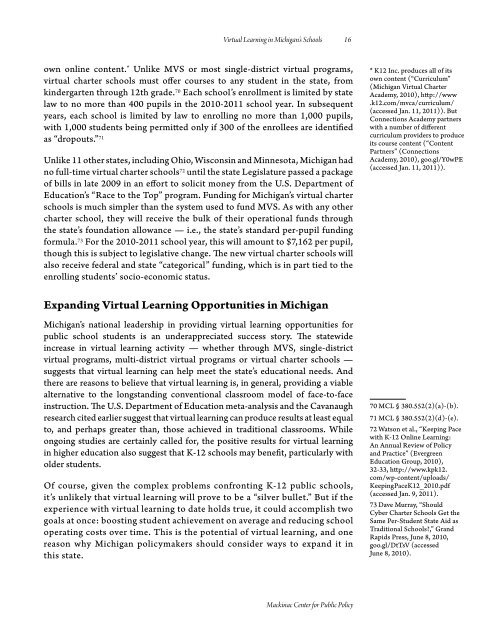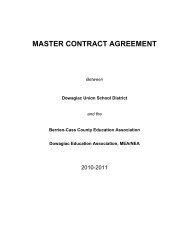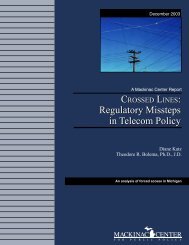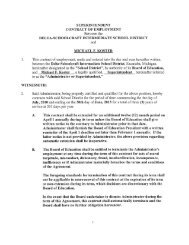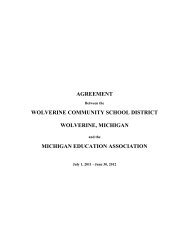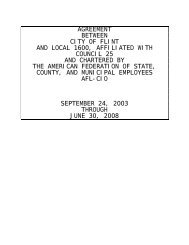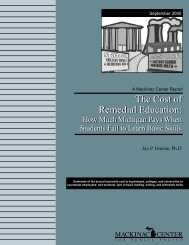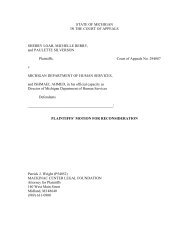by Michael Van Beek - Michigan Virtual University
by Michael Van Beek - Michigan Virtual University
by Michael Van Beek - Michigan Virtual University
You also want an ePaper? Increase the reach of your titles
YUMPU automatically turns print PDFs into web optimized ePapers that Google loves.
<strong>Virtual</strong> Learning in <strong>Michigan</strong>’s Schools 16own online content.* Unlike MVS or most single-district virtual programs,virtual charter schools must offer courses to any student in the state, fromkindergarten through 12th grade. 70 Each school’s enrollment is limited <strong>by</strong> statelaw to no more than 400 pupils in the 2010-2011 school year. In subsequentyears, each school is limited <strong>by</strong> law to enrolling no more than 1,000 pupils,with 1,000 students being permitted only if 300 of the enrollees are identifiedas “dropouts.” 71Unlike 11 other states, including Ohio, Wisconsin and Minnesota, <strong>Michigan</strong> hadno full-time virtual charter schools 72 until the state Legislature passed a packageof bills in late 2009 in an effort to solicit money from the U.S. Department ofEducation’s “Race to the Top” program. Funding for <strong>Michigan</strong>’s virtual charterschools is much simpler than the system used to fund MVS. As with any othercharter school, they will receive the bulk of their operational funds throughthe state’s foundation allowance — i.e., the state’s standard per-pupil fundingformula. 73 For the 2010-2011 school year, this will amount to $7,162 per pupil,though this is subject to legislative change. The new virtual charter schools willalso receive federal and state “categorical” funding, which is in part tied to theenrolling students’ socio-economic status.* K12 Inc. produces all of itsown content (“Curriculum”(<strong>Michigan</strong> <strong>Virtual</strong> CharterAcademy, 2010), http://www.k12.com/mvca/curriculum/(accessed Jan. 11, 2011)). ButConnections Academy partnerswith a number of differentcurriculum providers to produceits course content (“ContentPartners” (ConnectionsAcademy, 2010), goo.gl/Y0wPE(accessed Jan. 11, 2011)).Expanding <strong>Virtual</strong> Learning Opportunities in <strong>Michigan</strong><strong>Michigan</strong>’s national leadership in providing virtual learning opportunities forpublic school students is an underappreciated success story. The statewideincrease in virtual learning activity — whether through MVS, single-districtvirtual programs, multi-district virtual programs or virtual charter schools —suggests that virtual learning can help meet the state’s educational needs. Andthere are reasons to believe that virtual learning is, in general, providing a viablealternative to the longstanding conventional classroom model of face-to-faceinstruction. The U.S. Department of Education meta-analysis and the Cavanaughresearch cited earlier suggest that virtual learning can produce results at least equalto, and perhaps greater than, those achieved in traditional classrooms. Whileongoing studies are certainly called for, the positive results for virtual learningin higher education also suggest that K-12 schools may benefit, particularly witholder students.Of course, given the complex problems confronting K-12 public schools,it’s unlikely that virtual learning will prove to be a “silver bullet.” But if theexperience with virtual learning to date holds true, it could accomplish twogoals at once: boosting student achievement on average and reducing schooloperating costs over time. This is the potential of virtual learning, and onereason why <strong>Michigan</strong> policymakers should consider ways to expand it inthis state.70 MCL § 380.552(2)(a)-(b).71 MCL § 380.552(2)(d)-(e).72 Watson et al., “Keeping Pacewith K-12 Online Learning:An Annual Review of Policyand Practice” (EvergreenEducation Group, 2010),32-33, http://www.kpk12.com/wp-content/uploads/KeepingPaceK12_2010.pdf(accessed Jan. 9, 2011).73 Dave Murray, “ShouldCyber Charter Schools Get theSame Per-Student State Aid asTraditional Schools?,” GrandRapids Press, June 8, 2010,goo.gl/DtTsV (accessedJune 8, 2010).Mackinac Center for Public Policy


